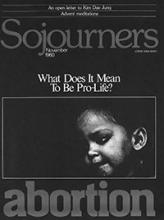On June 30, 1980, the U.S. Supreme Court handed down another in its long and controversial series of opinions on the subject of human abortion. This time the court concluded that federal and state governments were under no Constitutional obligation to fund abortions under the Medicaid program.
Anti-abortion groups claimed a victory, saying that taxpayers should not be forced to pay for abortions against their wishes. Abortion proponents, noting that the Congress and a majority of state legislatures have already gone on record in opposition to abortion funding, said that the ruling would drastically limit abortion access for poor women. Both responses reflected an accurate analysis of the court's action, and both were entirely predictable. What neither group noted, however, is that the welfare abortion controversy is as much a matter of welfare as it is a question of abortion.
Reasons cited in favor of funding abortions under Medicaid fall within two general headings: the equal access and economic arguments. According to the former theory, rich women are able to "choose" abortions and to finance them for themselves, so the government ought to allow indigent women the same option by subsidizing the procedure with Medicaid dollars. The second theory sees poverty itself as a compelling reason to abort, and presents "evidence" to support a conclusion that both the poor themselves and the society as a whole will benefit from a welfare abortion program.
In order to understand the error of these arguments, it is necessary to relate the welfare-abortion question to a culture of inequality which is responsible for making poverty itself an institution that can be simultaneously tolerated and condemned by reformists. The economics of poverty and the economics of abortion are inseparable.
Read the Full Article

